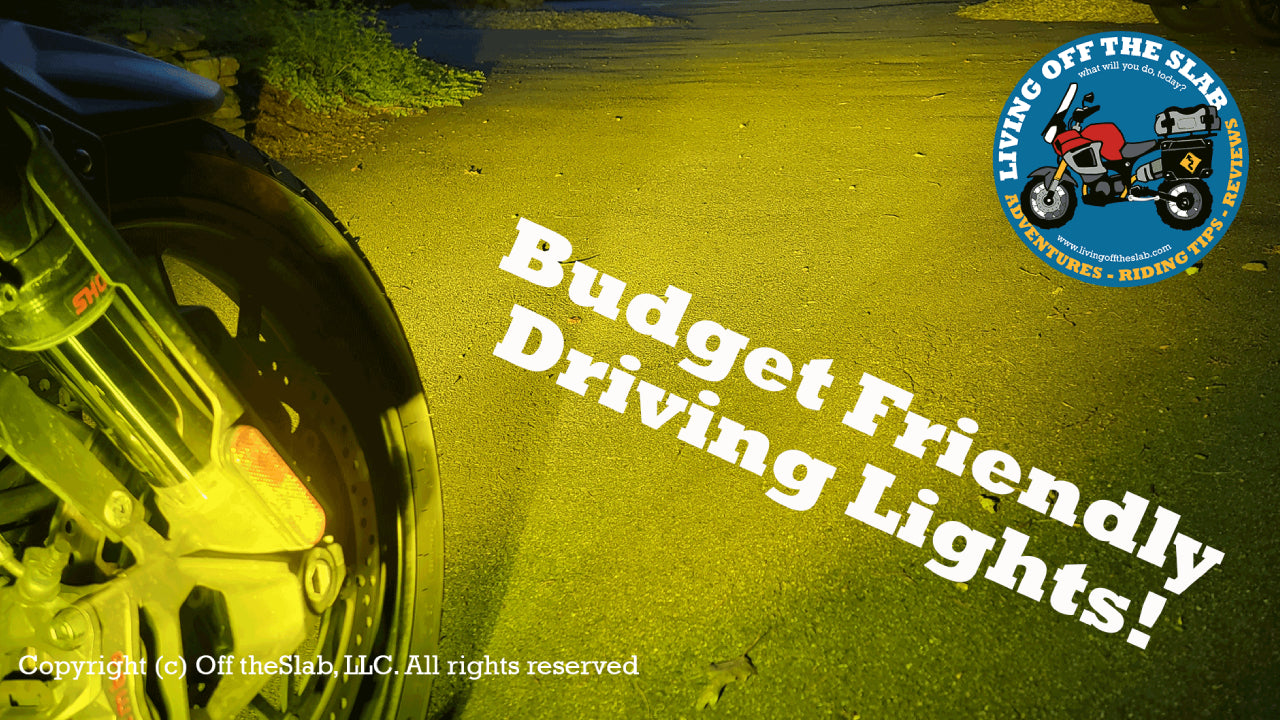Installation Instructions
I have been thinking about adding a set of daytime running lights to my Triumph Tiger 1200 GT Explorer. Whenever I see one of those big BMW GS with the yellow running lights, it really gets my attention, much more so than high-viz riding gear. However, I have been holding off on adding these lights because of cost concerns. A set of Clearwater or Denali lights can run as much as $800 and I just cannot justify that kind of cost. But what if I could do something similar with a much lower cost?
Watch the video (live 8/27/23): https://youtu.be/5SmhAox6PtU
With all of that in mind, was contacted by a company called Co-light to do a review of their Rob 2 Pro driving lights. These are a dual beam light with a single on and off switch (no high/low beam) which is exactly what I was looking for.
GET 12% OFF WITH THIS COUPON CODE "SLAB12"
The Rob 2 Pro retails for $97.00 and is currently on sale for $78. The kit comes with 2 Rob 2 Pro lights and some simple mounting hardware.

Wiring Harness
The wiring harness can be purchased for an additional $21.99. At the time of this writing, the only wiring harnesses available from Co-light are three wire in nature and the Rob 2 Pro lights are two wire. I am told that a two wire harness is in the works, but for now you will have to use the three wire, or create your own. In this blog, I will show you how to wire both the three wire harnesses to your lights as well as create your own custom version.
Assembling the Custom Mounts
I then used the Co-light bracket and drilled out the hole to accept the threaded RAM ball.
The Co-light bracket is made with protrusions that would hold a nut in place. We need to fill the gap between the bracket and the top of the protrusions. To do that, I took a 10M washer and flattened it out with my grinder to fit the slot. I then painted them black.
I then installed the modified washers, a thin copper washer and the fender nut to the threaded end of the RAM ball.
NOTE: The nut show here is larger. I replaced this with the jam nut indicated above.

Once I had the ball attached to the bracket, I then clamped the RAM ball to my crash guards and installed the extension arm. After repeating this on the other side, I was now to mount the lights.
Using the Co-Light Electrical Harness
If you want to use the Co-light electrical harness, it is pretty easy to install. The Harness comes with a relay box, wiring for two lights, wiring for the switch, a trigger wire and of course hot and ground wires. There are also two pigtails that will be attached to the lights themselves.
With the exception of the hot, ground and trigger wires, all other connections are made with easy, screw on connectors.
Wiring the Pig Tails to the Lights
The first thing you will need to do is to add the pigtails to the lights. As I mentioned above, the lights themselves have two wires and the harness has three wires.
The first thing you will need to do is to add the pigtails to the lights. As I mentioned above, the lights themselves have two wires and the harness has three wires.
The harness uses a red wire (hot low-beam), yellow wire (hot high-beam) and a black wire (ground). The Rob 2 Pro lights only have the red and black wires.
To use the harness you have two options.
- Leave the yellow wire unconnected (as in the image above).
-
Wire the red and yellow wires together (what I suggest).
Leaving the yellow wire unconnected will cause the switch to operate on every other click. Wiring the red and yellow wires together will allow the switch to work each time it is pressed, tuning the lights on and off. You can see how this works in the video accompanying this blog.
To connect the wiring I suggest either soldering or using the solder/shrink wrap connector (this is what I do).These connectors can be found on Amazon and make wiring jobs easy and clean. After I have the wires connected, I always cover with an extra layer of shrink tubing.
Using the pigtails as an example, I connect the red hot wire from the light to the red and yellow wire of the harness.
I suggest using a solder and seal connector to join the three wires.
How to Position the Wires for Heating
This is an example of how to join the three wires.
You will also have to join the black, ground wires, so you should strip the black casing off the harness to give yourself more room.
Here is an example of how three wires join in such a manner would look after heating.
Don't Forget the Shrink Tubing
To finish off the join, I always finish off with a length of shrink tubing. It just makes the install look more professional and gives an extra layer of water protection.
Make sure you slip the shrink tubing over the wires before connecting them.
Before continuing, I suggest running a test to make sure your connections are good between the lights and the pigtails. You can do this by connecting each light (in turn) to the battery.
Figure Out How to Run the Harness
Once you have the pigtails attached, you would need to figure out how you are going to run the harness. This is of course specific to your bike and may require that you remove side panels etc.
Find a place to mount the switch.
You will also need to find a good location to place the relay box. Usually this can be mounted under your seat or in the battery compartment. Again this will vary according to your bike.
Once you have run the wiring harness and have attached the lights and switch, you will need to connect it to your bike's electrical system.
The red wire from the harness goes to the positive terminal of your battery.
NOTE: In this image I connected the blue wire to the positive terminal for testing.
DO NOT DO THIS! THE BLUE WIRE SHOULD GO TO A KEYED CIRCUIT.
The black wire from the harness goes to the negative terminal of your batter.
The blue wire is the trigger wire and must be attached to a “keyed” hot wire. A keyed wire is one that is live only when the bike is powered up.
Refer to your bikes wiring diagram to locate a good keyed trigger location.
In the past I have used the wire that powers the light over my license plate or a keyed accessory power port. You will need to find the location that works best for your motorcycle, but make sure the wire is only hot when the bike is powered up otherwise you will eventually run down your battery.
To attach the trigger wire, you can use a “Posi Tap” or some kind of “vampire clamp.”
Once connected, test your install and then clean everything up with a few well placed zip ties.
Creating Your Own Harness
In my case, I decided not to use the Co-light harness because I have installed a PDM60 on my Triumph Tiger 1200. The PDM60 is a solid state device that acts as a set of fuses and relays for up to 6 circuits. Each of this circuits can be programmed for your needs for up to a total 60 amps of service.
The benefits of the PDM60 is that it isolates all of your accessories from the bikes main electrical system and eliminates the need for separate fuses and relays each time you add a new piece of equipment.
Steps for Creating the Harness
I measured and cut the wires for both sides. The length was slightly different due to routing. I made sure to leave plenty of extra (I will trim later).
Female connector goes on the lights and the male on the wires leading to the battery.
Cover Wires with Shrink Tubing
Once I had the connecters in place and I had tested to make sure every thing worked, I determined where the two side would be joined together. I then covered both lines (red and black wires with shrink tubing up to the join location. You could use electrical tape for this step.
Join the Red Wires From Each Side Together
To the right is an example of how I made the join using the Solder and Seal connectors.
I also covered this join with shrink tubing.
Join the Black Wires From Each Side Together
I used the same process to join the black wires together and finished it off with shrink tubing.
The result of these two joins was a single red line and a single black line that would be tied into the PDM60.
Join the Red Wire to the PDM60
I then selected a circuit on the PDM60. I used an open 15 amp circuit which is more than enough. The lights draw about 3 amps each.
I then cut and joined the using a Solder and Seal connector and covered the join with shrink tubing.
Join the Black, Ground Wire to the Common Ground Terminal
The PDM60 uses a common grounding post attached to the battery's negative terminal. I added a terminal ring to the black wire and added it to the common ground.
GET 12% OFF WITH THIS COUPON CODE "SLAB12"
Use the button below and the coupon will be automatically applied.
Test and Button Things Up!
Once everything was connected, I turned on the bike and tested the lights. Everything worked, so I buttoned everything up with a couple of well placed zip ties and reinstalled my side panels and seats.
That’s it. The lights are working great so far. I will let you know how they do over the remainder for the riding season.
Ride save my friends
–Craig Ripley

























